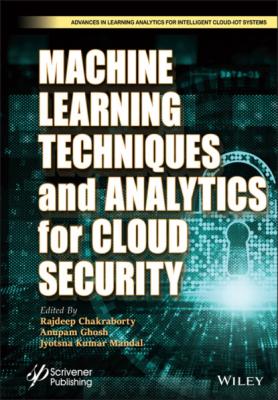Machine Learning Techniques and Analytics for Cloud Security. Группа авторов
Чтение книги онлайн.
Читать онлайн книгу Machine Learning Techniques and Analytics for Cloud Security - Группа авторов страница 33
 Natl. Acad. Sci. U.S.A., 114, 28, 7414–19, 2017.
Natl. Acad. Sci. U.S.A., 114, 28, 7414–19, 2017.
3. Yang, Z., Jin, M., Zhang, Z., Lu, J., Hao, K., Classification based on feature extraction for hepatocellular carcinoma diagnosis using high-throughput dna methylation sequencing data. Proc. Comput. Sci., 107, 412–417, 2017.
4. Rachman, A.A. and Rustam, Z., Cancer classification using Fuzzy C-Means with feature selection. 12th International Conference on Mathematics, Statistics, and Their Applications (ICMSA), pp. 31–34, 2016.
5. Ghosh, A. and De, R.K., Fuzzy Correlated Association Mining: Selecting altered associations among the genes, and some possible marker genes mediating certain cancers. Appl. Soft Comput., 38, 587–605, 2015.
6. Mao, Z.-Y., Cai, W.-S., Shao, X.-G., Selecting significant genes by randomization test for cancer classification using gene expression data. J. Biomed. Inform., 46, 4, 549–601, 2013.
7. Cao, J., Zhang, L., Wang, B., Li, F., Yang, J., A fast gene selection method for multi-cancer classification using multiple support vector data description. J. Biomed. Inform., 53, 381–389, 2015.
8. Dashtban, M. and Balafar, Gene selection for microarray cancer classification using a new evolutionary method employing artificial intelligence concepts. Genomics, 109, 2, 91–107, 2017.
9. Mirza, B., Wang, W., Wang, J., Choi, H., Chung, N.C., Ping, P., Machine Learning and Integrative Analysis of Biomedical Big Data. Genes, 10, 2, 87, 2019.
10. Hoadley, K.A. et al., Multiplatform analysis of 12 cancer types reveals molecular classification within and across tissues of origin. Cell, 158, 929–944, 2014.
11. Yang, A. et al., Bayesian variable selection with sparse and correlation priors for high-dimensional data analysis. Comput. Stat., 32, 1–17, 2016.
12. Danaee, P., Ghaeini, R., Hendrix, D.A., A deep learning approach for cancer detection and relevant gene identification. Pac. Symp. Biocomput., 22, 219–229, 2017.
13. Kourou, K., Exarchos, T.P., Exarchos, K.P., Karamouzis, M.V., Fotiadis, D.I., Machine learning applications in cancer prognosis and prediction. Comput. Struct. Biotechnol. J., 13, 8–17, 2014.
14. Tabl, A.A., Alkhateeb, A., ElMaraghy, W., Rueda, L., Ngom, A., A machine learning approach for identifying gene biomarkers guiding the treatment of breast Cancer. Front. Genet., 10, 256, 2019.
15. Huang, S., Cai, N., Pacheco, P.P., Narrandes, S., Wang, Y., Xu, W., Applications of Support Vector Machine (SVM) Learning in Cancer Genomics. Cancer Genomics Proteomics, 15, 1, 41–51, 2018.
16. Rajaguru, H., Analysis of Decision Tree and K-Nearest Neighbor Algorithm in the Classification of Breast Cancer. Asian Pac. J. Cancer Prev., 20, 12, 3777–378, 2019.
17. Neha, K. and Verma, K., Volume 10, May-June 2019.A survey on various machine learning approaches used for breast cancer detection. IJARCS, 10, 3, 76–79, 2019.
18. Libbrecht, M.W. and Noble, W.S., Machine learning applications in genetics and genomics. Nat. Rev. Genet., 16, 321–332, 2015.
19. Gao, F., Wang, W., Tan, M. et al., DeepCC: a novel deep learning-based framework for cancer molecular subtype classification. Oncogenesis, 8, 9, 44, 2019.
20. Sultana, J., Predicting Breast Cancer using Logistic Regression and Multi-Class Classifiers. Int. J. Eng. Technol.(UAE), 7, 4.20, 22–26, 2018.
21. Alkuhlani, A., Nassef, M., Farag, I., Multistage feature selection approach for high-dimensional cancer data. Soft Comput., 21, 6895–6906, 2017.
22. Kavitha, R.K., Ram, A.V., Anandu, S., Karthik, S., Kailas, S., Arjun, N.M., PCA-based gene selection for cancer classification. 2018 IEEE International Conference on Computational Intelligence and Computing Research (ICCIC), Madurai, India, pp. 1–4, 2018.
23. Wu, W. and Faisal, S., A data-driven principal component analysis-support vector machine approach for breast cancer diagnosis: Comparison and application. Trans. Inst. Meas. Control, 42, 7, 1301–1312, 2020.
24. Deshmukh, P., Design of Cloud Security in the EHR for Indian Healthcare Services. J. King Saud Univ. – Comp. Info. Sci., 29, 3, 281–287, 2017.
25. Langmead, B. and Nellore, A., Cloud computing for genomic data analysis and collaboration. Nat. Rev. Genet., 19, 4, 208–219, 2018.
1 *Corresponding author: [email protected]
4
Cost-Effective Voice-Controlled Real-Time Smart Informative Interface Design With Google Assistance Technology
Soumen Santra1, Partha Mukherjee2 and Arpan Deyasi3*
1 Department of Computer Application, Techno International Newtown, Kolkata, India
2 Infiflex Technologies Pvt Ltd, Kolkata, India
3 Department of Electronics and Communication Engineering, RCC Institute of Information
Abstract
In 21st century, passive intelligence makes a new surrounding around humans through various natural and intelligent interfaces which are interconnected with different computing devices. It creates a user-authenticated and also authorized smart milieu for endowing efficient support to individual communications and convenience. This technology integrates reasoning, processing, sensing, and capabilities of network formation along with other diverse relevance and applications, supports, and services, providing easy access to web contents (audio, video, text, and other file formats). The present work as proposed here is directed and sharply focused toward architectural design and improvement of a mirror boundary with smart informative system embedded within it for the smart terrain environment of home.
Here, we propose a smart real-time interface in such a way that even though it provides us with the mirror like effect, it also smart enough to view us multiple information like news, clock, calendar events, and fitness tracking on the background. The information is relayed with the help of a LCD screen behind the glass. The proposed automation system is associated where voice instructions (Google Assistance) in alliance with sensors are utilized for controlled authoritarian measures.
The proposed system/architecture has high reliability for the senior citizen and also for handicapped or especially able people moving with wheelchair and is dependent on others. It is also applicable on the areas where you need your appliance to work without reaching the switch board and for saving energy. By virtue of its real-time nature due to application of machine intelligence, it may be the system can be implemented in households with very less cost.
Keywords: Informative interface, passive intelligence, real-time smart system, voice-controlled mechanism, Google Assistant technology, cloud